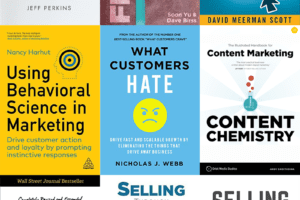Episode 92 of Yes, and Marketing
Q: Who are the bigger liars, statisticians or marketers?
A: Marketers ????
The good news? We’ve got advice from Atul Minocha on kicking that habit and building credibility as marketers.
Atul is a multi-time CMO, angel investor, professor of marketing, and author of “Lies, Damned Lies, and Marketing.”
As a partner with consulting group Chief Outsiders, he serves as a fractional CMO for growth and midsized companies, giving him rare insight into business and marketing strategies across both startups and Fortune 500 companies.
In this episode, Atul shares nuggets of wisdom on all aspects of marketing:
- Common market research mistakes
- Why marketers should pay attention to the primal brain first
- How to build credibility as a marketer (especially when it comes to ROI)
- When more data isn’t the answer
Thanks to Doug Burdett, host of the Marketing Book Podcast, who named Atul the best new marketing author of 2021 and recommended him to the show.
Guest-at-a-Glance
???? Name: Atul Minocha
???? What he does: Author of Lies, Damned Lies, and Marketing. Fractional CMO with Chief Outsiders.
????️ Find Atul on the web: Chief Outsiders | Website | LinkedIn
???? Get smart: “Getting richer conversations going, even with a handful of customers, is far better than getting middling answers from a thousand customers.”
Top Takeaway
One common marketing lie: ROI ????
Too often, marketers promise something they shouldn’t.
“One of the most common examples of this is on ROI (return on investment) on marketing dollars,” Atul explains. “It’s very commonplace for CEOs to insist on, ‘Show me the ROI. You want to do this? What will I get for it?’”
It’s a fair question—CEOs are used to making business decisions based on ROI. In marketing, however, true ROI is often impossible to measure, and focusing on it could lead you in the wrong direction.
Atul shares a story of two different clients he worked with who went to the same trade shows. One client made 80 percent of their annual sales from purchase orders picked up at that trade show, while the other client never picked up any purchase orders there.
“As a marketer, should I tell the first company ‘Double down on that, kill everything else, because 80% is coming from there—why bother with anything else that you might be spending on?’” Atul asks. “And tell the other guy, ‘Don’t spend any money on that?’”
The answer? No.
“That would be a wrong answer for both of them,” he says. “Because of digital marketing—because of all the different channels people have—attribution is very difficult.”
In the case of the first company, their customers might have decided to purchase based on other interactions with them—maybe on Facebook, an email campaign, their website, etc.—and simply took the final step of submitting a purchase order at the show. If the company stops investing in those other touch points, they may lose those customers, despite still being at the trade show.
In the case of the second, they risk losing out on customers who see them at the trade show but make their final purchase decision later. If prospects don’t see them at the trade show, they might even wonder if the company has gone out of business.
“You cannot make decisions based purely on the number of sales divided by the cost for a trade show,” Atul says. “That’s a bad way of looking at it.”
Episode Highlights
Career advice to a young marketer
“Don’t become too specialized. As you progress in age, as you progress in seniority, the more of that full-span marketing that you can do, the better off you will be because that’s what will be expected of you.
…You don’t have to be equally good at everything, but you should have done everything by the time you become a CMO.”
Serve the primal brain first
“The best way to enter somebody’s brain is through the primal brain. If you can win my primal brain over with whatever you offer, I’ll say, ‘Oh good, let me spend some time,’ and then I’ll delegate it up to the rational brain—‘Now you make the decision, but I at least approve of this.’ That’s I think how it works, and that’s why a good marketer serves both the primal brain first, and then the rational brain.”
More data isn’t the answer
“Another common mistake many B2B marketers do is that they’ll say, ‘Oh, I’m talking to a PhD or I’m talking to a very intelligent group of engineers, so let me send them an Excel with all the data showing how good our product is compared to the competition.’ And that Excel is emailed, and then two weeks later, no decision is made and the guy says, ‘I’m still considering, I’m still debating which one to take.’
I say, ‘Well, they haven’t decided based on the 12 data points I gave them, maybe they need 10 more.’ So I give them a bigger Excel spreadsheet, hoping that now they’ll be overwhelmed with the data and they’ll make the decision, and nothing happens.
My advice to a company like that is, more data is not going to help you. What’s probably happening is that the primal brain is keeping you off or they’re getting overwhelmed not only by you, but the other guys too, so it’s a deer-in-the-headlights situation. The only way to break that log jam—the mental log jam—is to appeal to the emotional side. Once that door is open, things will go well.”
One common mistake in market research
“One flaw is that they believe that by simply asking the questions, they’ll get all the answers they want. In other words, ‘If I don’t know something, that’s simply because I did not ask that question.’ So they end up making the questions very exhaustive and exhausting and say, ‘Okay, now that I’ve got everything, now I know what the customer wants.’
The mistake there is that the customers sometimes don’t quite know what they want.”
Big M vs. small m marketing
“As consumers, most marketing that we see as consumers is what I call ‘small m’ marketing. The website, the logos, the promotions, the advertising, the blogs, Google ads, everything—all that is good. All that is useful. All that is what’s visible.
But if you’re a non-marketer, when you’re just a customer, you don’t get to see the strategy behind that. You don’t know what Starbucks was thinking when they came up with whatever they come up with, right? That is ‘big M’ marketing, the behind-the-scenes things that happen in a corporation that are not directly visible to the end user or the customer.
…The person doing big M marketing should understand how to translate that big M into small m, and the people who are doing small m marketing should have confidence in the people who are doing big M.”
The first conversation to have as a fractional CMO
“Most business leaders, regardless of the size, they have a business challenge. Either the sales are not growing as much as they should, or they have new competitor, or they have a desire to go to a new market or the competition has taken down the price—all of those are business challenges. Many of those can be solved by marketing.
So in our first conversation, even if the CEO starts with, ‘What will you do for me in marketing?’ We usually say, ‘Let’s step back a little, let’s talk about what is your business challenge as a CEO? What are you facing? What is it that you would like to see differently? What is your ‘here’ state and what is your ‘there’ state?’ And then we’ll see if marketing can build that bridge from here to there.”
How to build credibility as a marketer
“When they ask for an ROI, don’t say ‘Yeah, I’ll fake some numbers and give you an ROI because that’s what you want.’ Confront them, tell them why certain things can’t happen. Sensible people will thank you for that. Sensible people will reward you for that.”
Top Quotes
????️Atul:
“Planning is good, working hard is good—but the ability to make the most of what might come your way outside of your plan is equally important.”
“Humans, even if they’re engineers, even if they are NASA scientists, they are humans to begin with, and they may deny this, but there is a significant element of emotion in them.”
“Getting richer conversations going, even with a handful of customers, is far better than getting middling answers from a thousand customers.”
“Marketing is more about what you should be selling, what you should have in your inventory for future sales. Sales is about getting rid of what you have in inventory today.”
“Once you have the foundation laid out in big M marketing, you’ll get a much higher ROI on your small m marketing dollars.”



